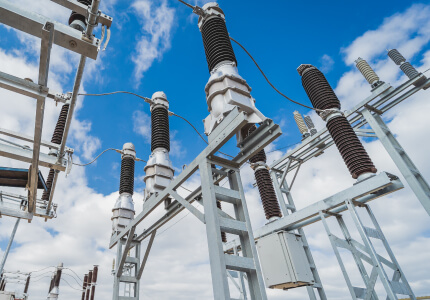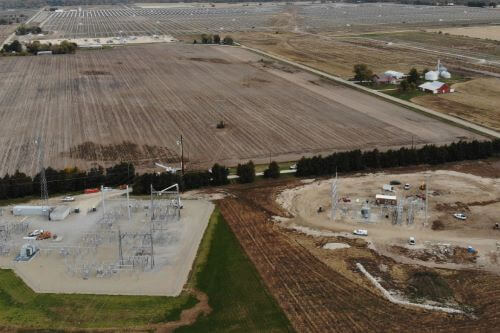Keeping up with the ever-changing energy landscape and the various supporting technologies driving it is critical for a host of reasons. At Ulteig, as the world changes and new challenges arise, we remain committed to ensuring that the infrastructures within each of our Lifeline Sectors® (Power, Renewables, Transportation and Water) stay up to date — not only to meet demand but also to maintain sustainability and safety.
What does staying in the now mean? It requires making an active effort to follow emerging energy trends very closely. Only then can we identify new opportunities, anticipate shifts in demand, adapt strategies and business models as needed, and innovate with solutions that truly move the industry forward.
Let’s take a closer look at three of the top energy trends making headway in 2024 and beyond.
1. Grid Control Management
The Issue: Adopting new sources of energy and power with a need to expand — and maximize — the high-voltage power grid.
The move away from fossil fuels while we become more reliant on electricity to power heating and technology loads has become commonplace. While we can strive to utilize our existing assets in more creative ways, as more resources come into play, expansion of the power grid is inevitable.
“As our energy mix changes, how we utilize that grid and upscale it are necessary things to do,” says Eric Stern, Ulteig’s Technology Innovation Director.
With the move to electrification, the grid infrastructure needs to grow, but there are discrepancies on how fast that growth should be. Yet with more and more of us relying on technology in our day-to-day lives, from mobile devices to computers, electric cars and the like, the grid is becoming increasingly congested.
The Emerging Solution: New DLR Technology
A DLR solution ultimately helps manage the power grid by calculating and understanding its electrical transmission capacity in real time, helping improve efficiency, minimizing congestion that can tax the grid, and allowing for more demand during grid growth.
2. Wildfire Early Detection Technology
The Issue: An increase in fire incidents in fire-prone areas surrounding the wildland-urban interface.
“Take a brief look back at recent history, you’ll see some pretty big fires with some tragic losses,” says Tom Robinson Sr. Project Manager of Tech & Innovation. “Large fires caused by human interaction with the environment — oftentimes they are caused by stray sparks from human activity, but occasionally, they are caused by failed or aging infrastructure.”
He continues, “Wildland-urban interface fires are not going away anytime soon. The size and the frequency are only going up. Events that are causing these wildfires to expand rapidly — be it extended droughts and/or wind events — are driving these fires from what used to be smaller and containable fires, to conflagrations that we can’t keep up with anymore.”
The Emerging Solution: Early Detection
“One of our biggest defenses is not starting as many fires as best we can, and we can do that with preemptive techniques between forestry management, managing the right of way in a power industry and then maintaining high-quality equipment in the field,” notes Robinson. “Behind that is early detection, and that’s where Ulteig can stop fires faster if we know they exist earlier.”
We are currently working on piloting two different types of wildfire detection systems with outside utility partners to determine which are the most effective from a cost, useability and physical detection standpoint because, according to Robinson, “we believe it’s going to be an emerging trend inside of the utility space.”
“In essence,” he continues, “we are diving into wildfire detection as a new tech trend to understand where the technology leaders will be, what technologies will win out over others and how we can help our utility partners pilot and deploy these technologies again with the overarching goal of early detection.”
3. AI and Machine Learning
The Issue: AI’s increasing role in an ever-changing energy infrastructure.
As AI language models like ChatGPT become household names (and see increasing improvements in their capabilities), they will likely change the way we communicate and do business. These technologies, on their own, aren’t enough to move our infrastructure — across all Lifeline Sectors — forward.
The Emerging Solution: Machine and Reinforcement Learning (ML/RL) Models
New technologies will ultimately affect how we operate the energy infrastructure — from running high-voltage distribution grids to managing water and wastewater.
“There are other subsets of AI, like Machine Learning (ML) and Reinforcement Learning (RL) that will affect how we manage the infrastructure that support us on a daily basis,” says Stephanie Kennedy, Sr. Project Manager of Tech & Innovation.
Our innovation engineering team has started a new pilot program utilizing RL as a solution to manage water pumping energy consumption and optimization.
“The ultimate goal,” Kennedy says, “is to optimize our pumping plans in the water and wastewater sectors versus being reactionary — the ability to feed large amounts of data into a reinforcement learning model, and for it to come up with creative and innovative solutions that are more effective and more efficient than traditional human operators.”
Innovating the Infrastructure
Across each Lifeline Sector, Ulteig works with internal and external partnerships to ensure that our energy infrastructure evolves. These are just a few emerging energy trends on the horizon; stay tuned to our blog for more detailed information on how they continue to power our everyday life.
For questions on our technology and innovation, feel free to contact us today.




